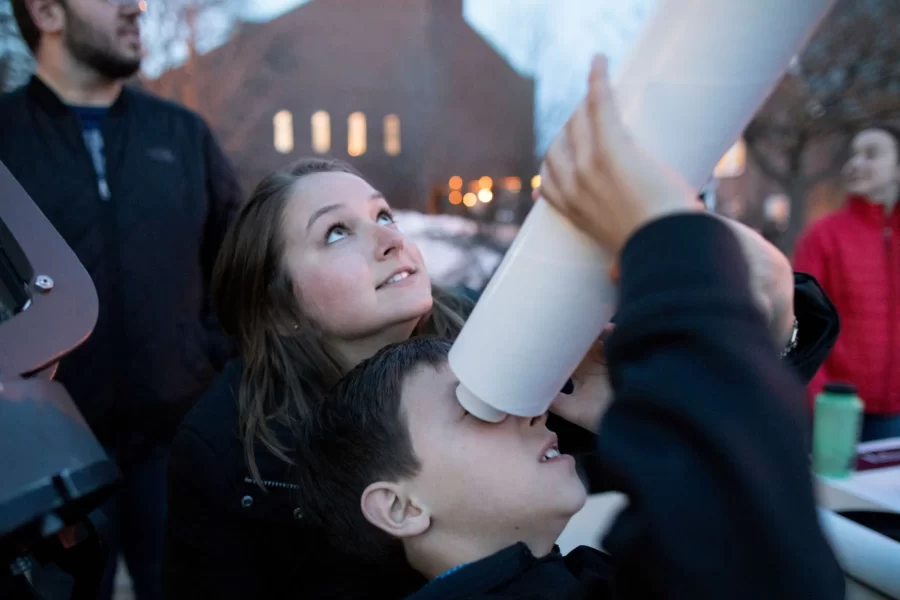Physics and Astronomy at Bates
Physics, the study of space, time, matter, and energy, is a fundamental component of a liberal education.
Physics, the study of space, time, matter, and energy, is a fundamental component of a liberal education. Introductory courses in physics and astronomy are designed to give students a broad background in the fundamentals of the discipline, an introduction to the logic and philosophy of science, and insight into the understanding and applications of contemporary physics and astrophysics.
Advanced courses provide greater depth and sophistication as the student’s background in physics and mathematics develops. Laboratory investigation, designed to accommodate each student’s particular needs, provides direct experience of the central role that experimental research plays in the advancement of science.
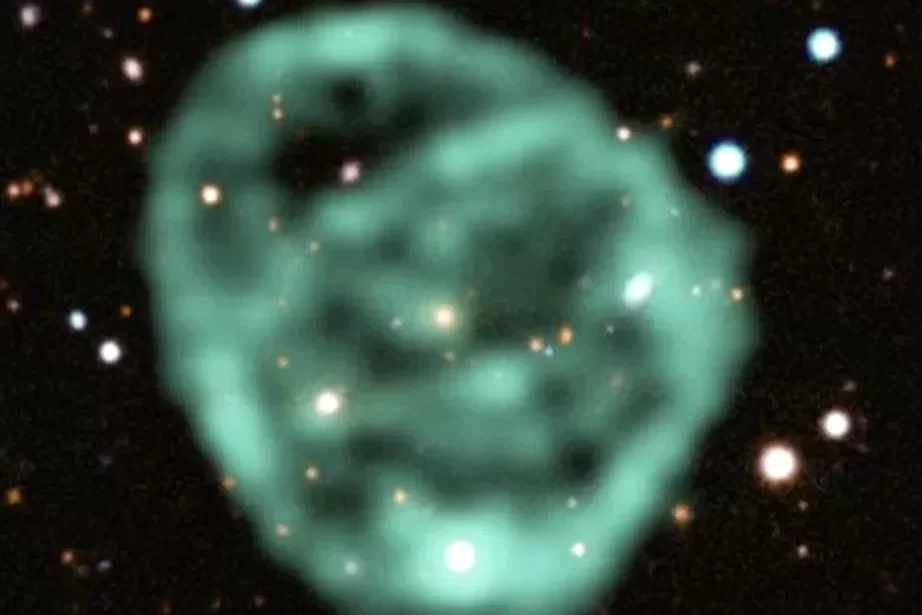
Research Highlight
Those odd circles in space? They’re now explained thanks to scientists including Aleks Diamond-Stanic.

Students from Associate Professor of Physics Aleks Diamond-Stanic’s Intro to Astronomy course held 20 interactive learning activities on topics including constellations, seasons, moon phases, planets and stars, gravity, telescopes, supernova explosions, and black holes. Caption info for Community Astronomy Night Mark Diamond-Stanic, 7, of Lewiston jumping Adam Joseph ’25 of Bloomfield, Conn., and Naomi Lynch ’25 of Farmingdale, Maine, at the rocket jumping station, seeing who can make the rocket go highest: the amount of force is related to how fat the rocket launches and how high it goes. It’s about how gravity works. Bates students jumping at this station: Zach Van Dusen in blue jacket, Sydney Schuster in purple bandana, Talia Skaistis in black and yellow, and Julia Neumann in green. Dexter Demers, 9, of Minot with Julia Johnson, Emmy Pike at Poster, Delaney Nwachukwu ‘24 The Electromagnetic Spectrum Hannah, 8, with brothers David, 6, and Evan, 4 (mother is Michelle Richards of Lewiston) Afonso, 5, of Lewison. His father is Afonso Ngola (afonsongola@hotmail.com). With sister Rebeca, 18 Teddy Rocque, 7, at moon phases station with Sadie Coleman ’25 and Serena McGrane Intro to Astronomy, Maddox, 8, of Lewiston Hula hooping Daphne Valen ’23 in sweatshirt Evan Antonakes ’23 amd Lincoln Rybeck ‘25 Boy Scout master Dan Poirier (615-9952) of Troop 1791 in Auburn Chad, 11, right; Wyatt, 11, center, and Calvin, 11 left
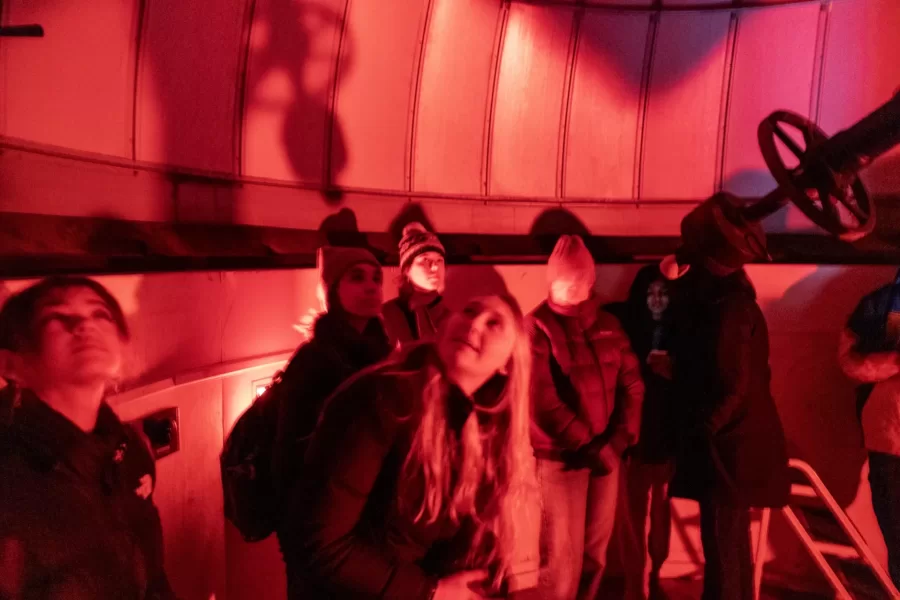
Evan Boxer-Cook ’26, of Scarborough, Maine, leads the Bates Astronomy Club from Carnegie 321 to the Stephens observatory, located on the roof of Carnegie, on January 15, 2025. (Theophil Syslo | Bates College)
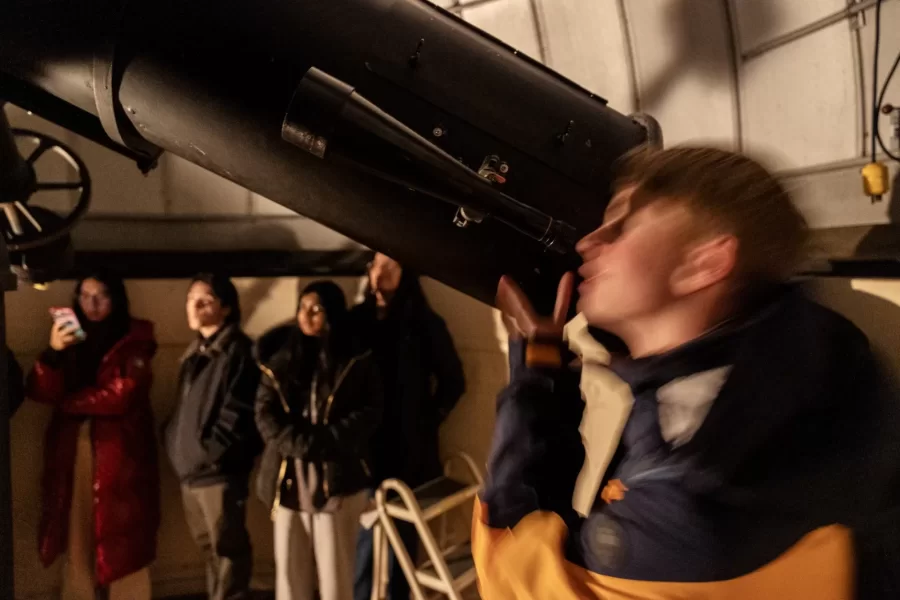
Evan Boxer-Cook ’26, of Scarborough, Maine, leads the Bates Astronomy Club from Carnegie 321 to the Stephens observatory, located on the roof of Carnegie, on January 15, 2025. (Theophil Syslo | Bates College)
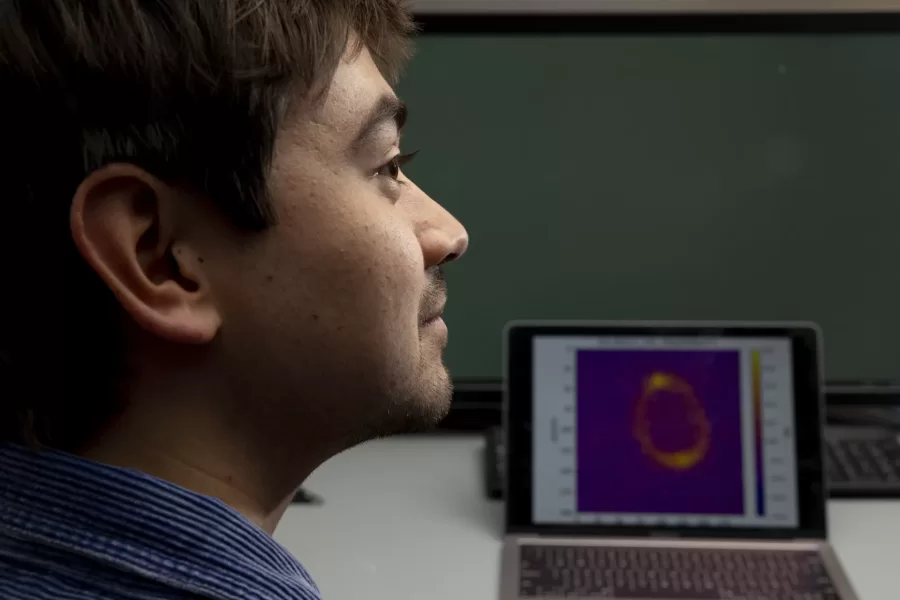
Professor of Physics Nathan Lundblad has received an award from NASA. He is collaborating with several students on the research and is shown here in his Carnegie Science Lab (Carnegie 146) with two of those students, Kona Lindsey ’23 of Colorado Springs, Colo., and Elias Veilleux ’23 (I gray shirt with glasses) of Orono, Maine Kona is shown with his laptop that display research images. Kona writes: “The image seen on my laptop is from an experiment run in the Cold Atom Lab on the International Space Station (ISS). It shows an ultracold gas bubble composed of rubidium atoms. The ring that is visible indicates that the atoms are occupying a shell, or bubble structure. You can see that the inside of the ring has few atoms, meaning the structure is truly hollow.”
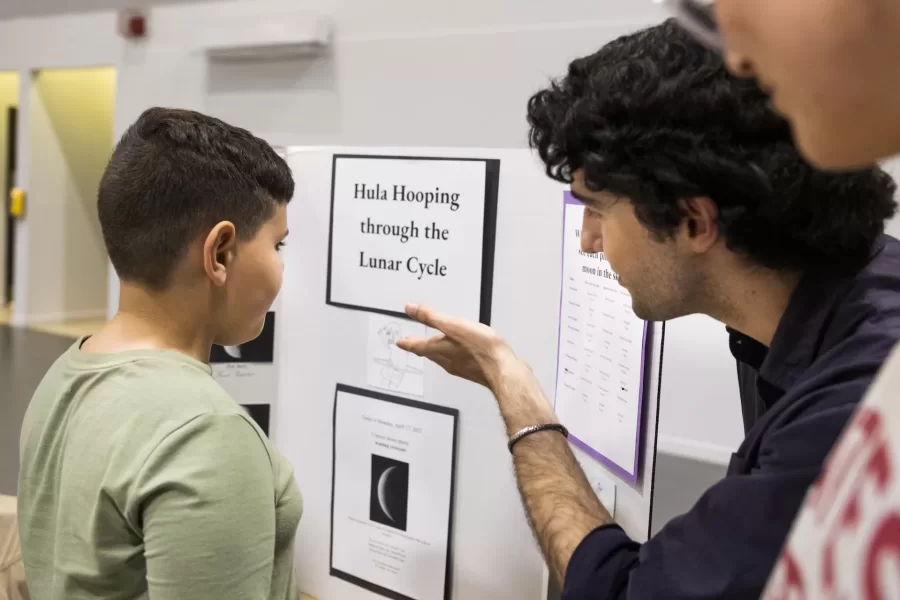
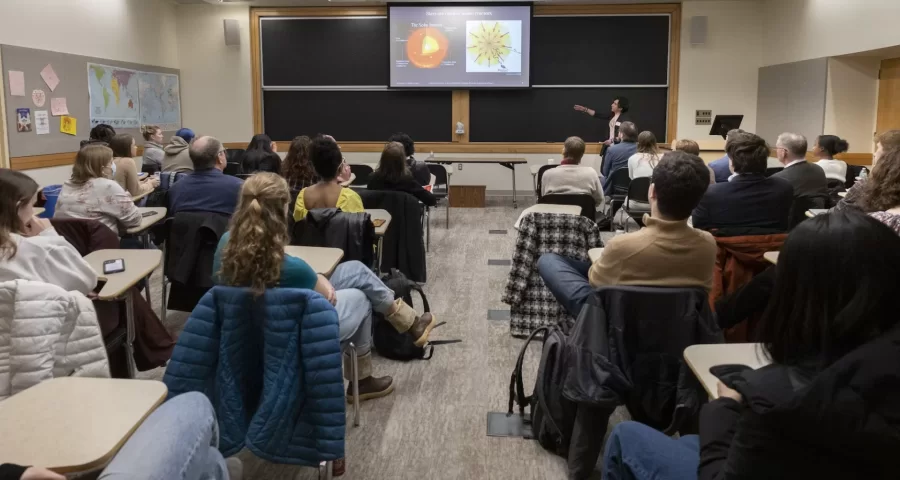
The Mount David Summit 2023 __________ Alecks Diamond-Stanic, Physics, and Brandon Villalta Lopez ’25, Kerry O’Brien Award
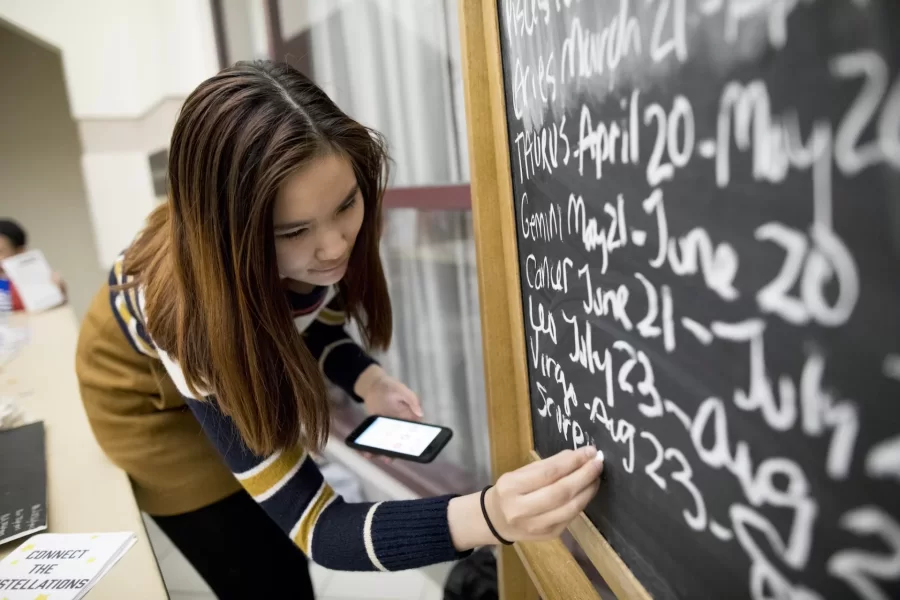
All kids agree; the moon looks WAY better up close! . Emily Morse ’17 (blue jeans) and Laura Nguyen ’19 with Connect the Constellations. Isla Shea, 6, of East Auburn School, uses a Carnegie telescope with 2,000x eye strength to view the moon as Evan Goldberg ’19 looks on during last night’s Bates Astronomy Extravaganza co-hosted by the Harward Center for Community Partnerships and the Bates College Physics and Astronomy Department. . Students in Astronomy 106, taught by Assistant Professor of Phyiscs Aleks Diamond-Stanic, ran hands on activities and planetarium shows to introduce children to black holes, galaxies, moons, planets, and more. Bates provided a fun night of getting kids excited about science.
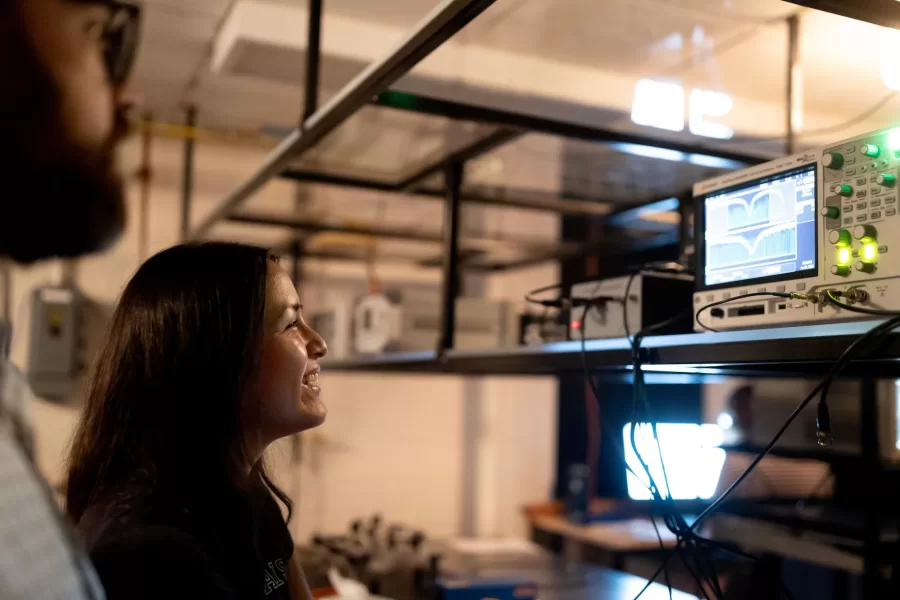
Assistant Professor of Physics Ryan Cole works with students in his Carnegie Science 156 lab on June 20, 2025. There is a secondary lab pictured in some of the photos that he and Paloma visited wearing goggles, where they used a laser to measure light frequencies. “Every once in a while, science makes sense,” he said at one point to the students. “Paloma is building an instrument to study very precisely sunlight and specifically the spectrum of sunlight for applications ultimately in exoplanets (planets orbiting other stars) detection and characterization. And then this table, which is Carson, Quinn, and Audrey (and Andrew Liu who is not here today) They are measuring how atmospheric gases like methane — specifically green house gases — interact with light to ultimately help us measure those things better in the atmosphere. Students photographed: Audrey Schane ’25, physics major, who is working as a research assistant with Cole this summer, Shown at the computer (striped t-shirt), where she is looking at a gas sample where she’s building something to control gas temperatures, with a vaccuum on the bottom. Paloma Rodriguez ’26, a physics major (black t-shirt) Carson Moellering ’26, physics major, looking at how methane absorbs light in different conditions (light reflecting back and forth in mirrors (white t-shirt) Qwynn Kobertz ’26, double major in physics and studio art, using a DSR laser exploring how to use this laser in a methane detecting app. (sunglasses on head) Here are two quick links that may help with some context for what we’re doing in the lab. My research website: https://sites.google.com/bates.edu/colelab/research-areas?authuser=0 NIST Article on optical frequency combs: https://www.nist.gov/topics/physics/optical-frequency-combs
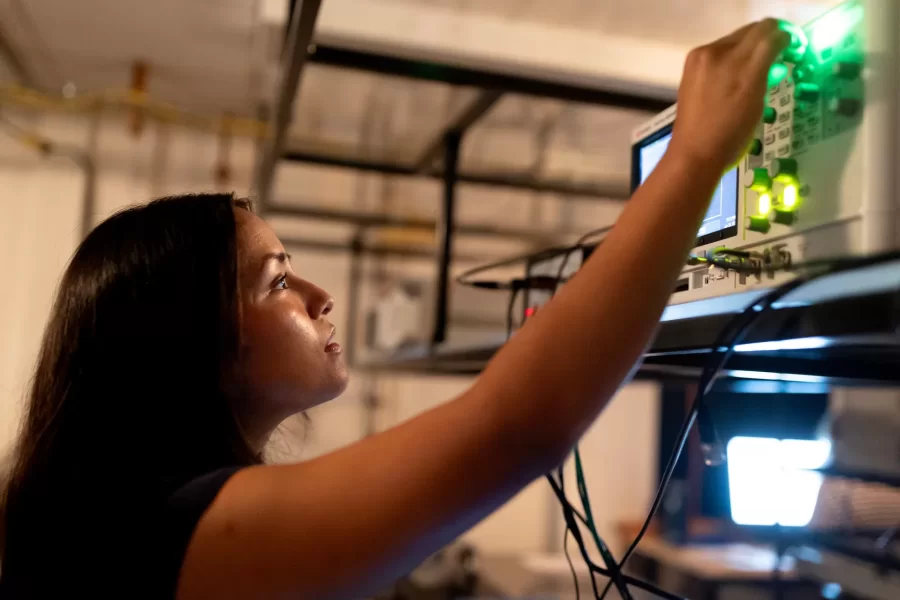
Assistant Professor of Physics Ryan Cole works with students in his Carnegie Science 156 lab on June 20, 2025. There is a secondary lab pictured in some of the photos that he and Paloma visited wearing goggles, where they used a laser to measure light frequencies. “Every once in a while, science makes sense,” he said at one point to the students. “Paloma is building an instrument to study very precisely sunlight and specifically the spectrum of sunlight for applications ultimately in exoplanets (planets orbiting other stars) detection and characterization. And then this table, which is Carson, Quinn, and Audrey (and Andrew Liu who is not here today) They are measuring how atmospheric gases like methane — specifically green house gases — interact with light to ultimately help us measure those things better in the atmosphere. Students photographed: Audrey Schane ’25, physics major, who is working as a research assistant with Cole this summer, Shown at the computer (striped t-shirt), where she is looking at a gas sample where she’s building something to control gas temperatures, with a vaccuum on the bottom. Paloma Rodriguez ’26, a physics major (black t-shirt) Carson Moellering ’26, physics major, looking at how methane absorbs light in different conditions (light reflecting back and forth in mirrors (white t-shirt) Qwynn Kobertz ’26, double major in physics and studio art, using a DSR laser exploring how to use this laser in a methane detecting app. (sunglasses on head) Here are two quick links that may help with some context for what we’re doing in the lab. My research website: https://sites.google.com/bates.edu/colelab/research-areas?authuser=0 NIST Article on optical frequency combs: https://www.nist.gov/topics/physics/optical-frequency-combs
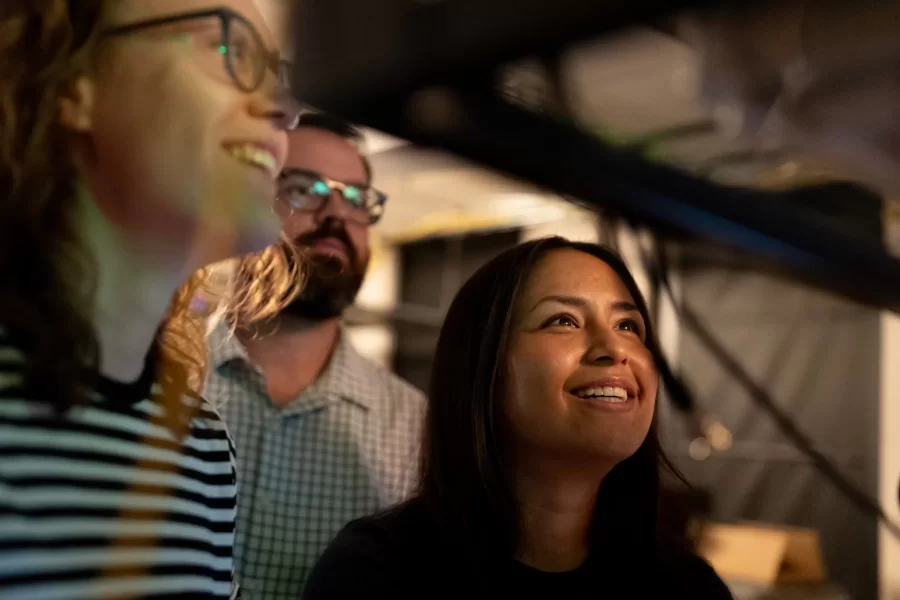
Assistant Professor of Physics Ryan Cole works with students in his Carnegie Science 156 lab on June 20, 2025. There is a secondary lab pictured in some of the photos that he and Paloma visited wearing goggles, where they used a laser to measure light frequencies. “Every once in a while, science makes sense,” he said at one point to the students. “Paloma is building an instrument to study very precisely sunlight and specifically the spectrum of sunlight for applications ultimately in exoplanets (planets orbiting other stars) detection and characterization. And then this table, which is Carson, Quinn, and Audrey (and Andrew Liu who is not here today) They are measuring how atmospheric gases like methane — specifically green house gases — interact with light to ultimately help us measure those things better in the atmosphere. Students photographed: Audrey Schane ’25, physics major, who is working as a research assistant with Cole this summer, Shown at the computer (striped t-shirt), where she is looking at a gas sample where she’s building something to control gas temperatures, with a vaccuum on the bottom. Paloma Rodriguez ’26, a physics major (black t-shirt) Carson Moellering ’26, physics major, looking at how methane absorbs light in different conditions (light reflecting back and forth in mirrors (white t-shirt) Qwynn Kobertz ’26, double major in physics and studio art, using a DSR laser exploring how to use this laser in a methane detecting app. (sunglasses on head) Here are two quick links that may help with some context for what we’re doing in the lab. My research website: https://sites.google.com/bates.edu/colelab/research-areas?authuser=0 NIST Article on optical frequency combs: https://www.nist.gov/topics/physics/optical-frequency-combs
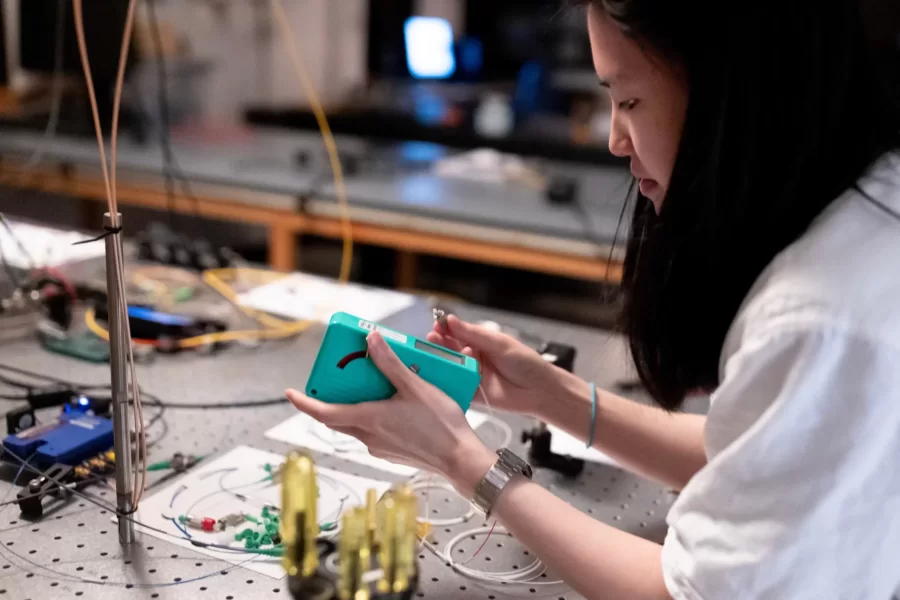
Assistant Professor of Physics Ryan Cole works with students in his Carnegie Science 156 lab on June 20, 2025. There is a secondary lab pictured in some of the photos that he and Paloma visited wearing goggles, where they used a laser to measure light frequencies. “Every once in a while, science makes sense,” he said at one point to the students. “Paloma is building an instrument to study very precisely sunlight and specifically the spectrum of sunlight for applications ultimately in exoplanets (planets orbiting other stars) detection and characterization. And then this table, which is Carson, Quinn, and Audrey (and Andrew Liu who is not here today) They are measuring how atmospheric gases like methane — specifically green house gases — interact with light to ultimately help us measure those things better in the atmosphere. Students photographed: Audrey Schane ’25, physics major, who is working as a research assistant with Cole this summer, Shown at the computer (striped t-shirt), where she is looking at a gas sample where she’s building something to control gas temperatures, with a vaccuum on the bottom. Paloma Rodriguez ’26, a physics major (black t-shirt) Carson Moellering ’26, physics major, looking at how methane absorbs light in different conditions (light reflecting back and forth in mirrors (white t-shirt) Qwynn Kobertz ’26, double major in physics and studio art, using a DSR laser exploring how to use this laser in a methane detecting app. (sunglasses on head) Here are two quick links that may help with some context for what we’re doing in the lab. My research website: https://sites.google.com/bates.edu/colelab/research-areas?authuser=0 NIST Article on optical frequency combs: https://www.nist.gov/topics/physics/optical-frequency-combs
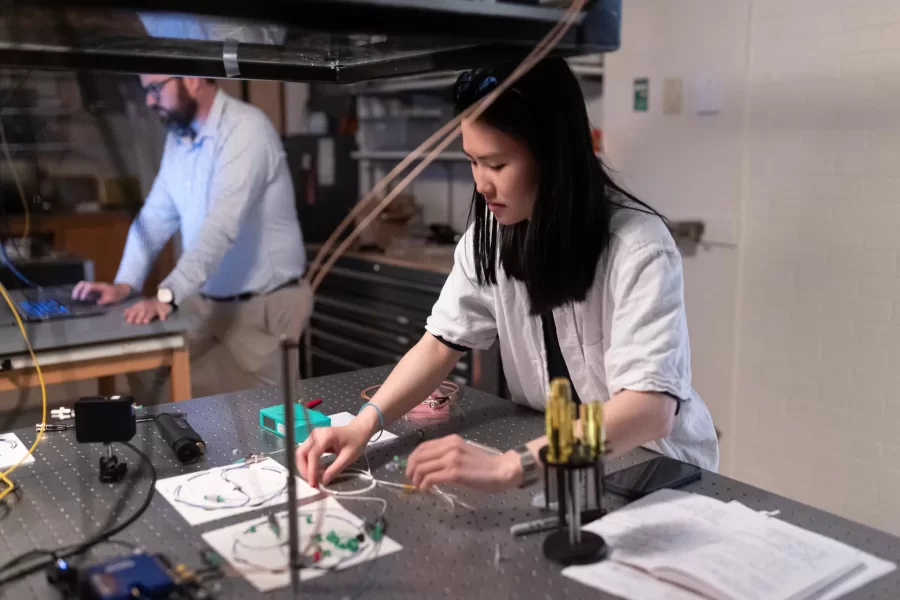
Assistant Professor of Physics Ryan Cole works with students in his Carnegie Science 156 lab on June 20, 2025. There is a secondary lab pictured in some of the photos that he and Paloma visited wearing goggles, where they used a laser to measure light frequencies. “Every once in a while, science makes sense,” he said at one point to the students. “Paloma is building an instrument to study very precisely sunlight and specifically the spectrum of sunlight for applications ultimately in exoplanets (planets orbiting other stars) detection and characterization. And then this table, which is Carson, Quinn, and Audrey (and Andrew Liu who is not here today) They are measuring how atmospheric gases like methane — specifically green house gases — interact with light to ultimately help us measure those things better in the atmosphere. Students photographed: Audrey Schane ’25, physics major, who is working as a research assistant with Cole this summer, Shown at the computer (striped t-shirt), where she is looking at a gas sample where she’s building something to control gas temperatures, with a vaccuum on the bottom. Paloma Rodriguez ’26, a physics major (black t-shirt) Carson Moellering ’26, physics major, looking at how methane absorbs light in different conditions (light reflecting back and forth in mirrors (white t-shirt) Qwynn Kobertz ’26, double major in physics and studio art, using a DSR laser exploring how to use this laser in a methane detecting app. (sunglasses on head) Here are two quick links that may help with some context for what we’re doing in the lab. My research website: https://sites.google.com/bates.edu/colelab/research-areas?authuser=0 NIST Article on optical frequency combs: https://www.nist.gov/topics/physics/optical-frequency-combs

Assistant Professor of Physics Ryan Cole works with students in his Carnegie Science 156 lab on June 20, 2025. There is a secondary lab pictured in some of the photos that he and Paloma visited wearing goggles, where they used a laser to measure light frequencies. “Every once in a while, science makes sense,” he said at one point to the students. “Paloma is building an instrument to study very precisely sunlight and specifically the spectrum of sunlight for applications ultimately in exoplanets (planets orbiting other stars) detection and characterization. And then this table, which is Carson, Quinn, and Audrey (and Andrew Liu who is not here today) They are measuring how atmospheric gases like methane — specifically green house gases — interact with light to ultimately help us measure those things better in the atmosphere. Students photographed: Audrey Schane ’25, physics major, who is working as a research assistant with Cole this summer, Shown at the computer (striped t-shirt), where she is looking at a gas sample where she’s building something to control gas temperatures, with a vaccuum on the bottom. Paloma Rodriguez ’26, a physics major (black t-shirt) Carson Moellering ’26, physics major, looking at how methane absorbs light in different conditions (light reflecting back and forth in mirrors (white t-shirt) Qwynn Kobertz ’26, double major in physics and studio art, using a DSR laser exploring how to use this laser in a methane detecting app. (sunglasses on head) Here are two quick links that may help with some context for what we’re doing in the lab. My research website: https://sites.google.com/bates.edu/colelab/research-areas?authuser=0 NIST Article on optical frequency combs: https://www.nist.gov/topics/physics/optical-frequency-combs
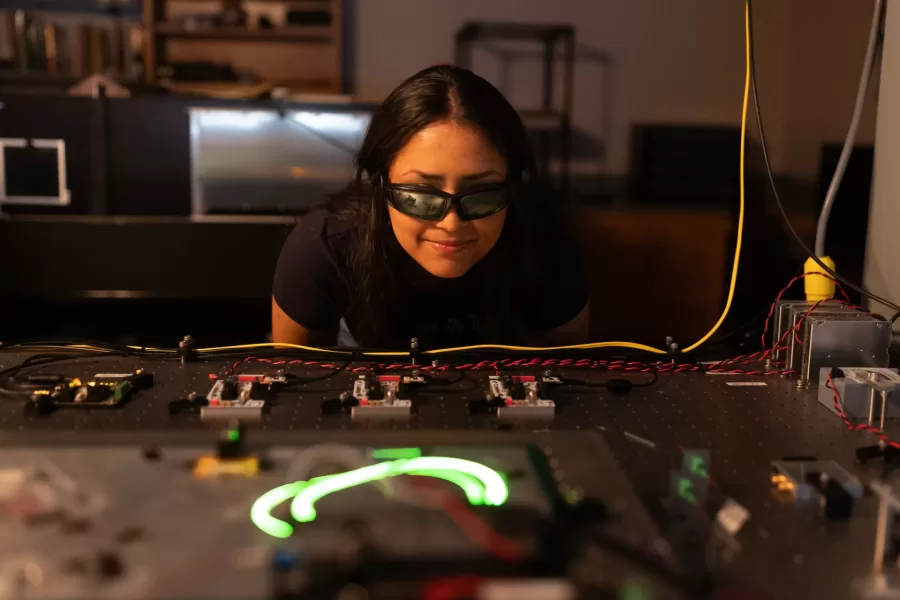
Assistant Professor of Physics Ryan Cole works with students in his Carnegie Science 156 lab on June 20, 2025. There is a secondary lab pictured in some of the photos that he and Paloma visited wearing goggles, where they used a laser to measure light frequencies. “Every once in a while, science makes sense,” he said at one point to the students. “Paloma is building an instrument to study very precisely sunlight and specifically the spectrum of sunlight for applications ultimately in exoplanets (planets orbiting other stars) detection and characterization. And then this table, which is Carson, Quinn, and Audrey (and Andrew Liu who is not here today) They are measuring how atmospheric gases like methane — specifically green house gases — interact with light to ultimately help us measure those things better in the atmosphere. Students photographed: Audrey Schane ’25, physics major, who is working as a research assistant with Cole this summer, Shown at the computer (striped t-shirt), where she is looking at a gas sample where she’s building something to control gas temperatures, with a vaccuum on the bottom. Paloma Rodriguez ’26, a physics major (black t-shirt) Carson Moellering ’26, physics major, looking at how methane absorbs light in different conditions (light reflecting back and forth in mirrors (white t-shirt) Qwynn Kobertz ’26, double major in physics and studio art, using a DSR laser exploring how to use this laser in a methane detecting app. (sunglasses on head) Here are two quick links that may help with some context for what we’re doing in the lab. My research website: https://sites.google.com/bates.edu/colelab/research-areas?authuser=0 NIST Article on optical frequency combs: https://www.nist.gov/topics/physics/optical-frequency-combs

Assistant Professor of Physics Ryan Cole works with students in his Carnegie Science 156 lab on June 20, 2025. There is a secondary lab pictured in some of the photos that he and Paloma visited wearing goggles, where they used a laser to measure light frequencies. “Every once in a while, science makes sense,” he said at one point to the students. “Paloma is building an instrument to study very precisely sunlight and specifically the spectrum of sunlight for applications ultimately in exoplanets (planets orbiting other stars) detection and characterization. And then this table, which is Carson, Quinn, and Audrey (and Andrew Liu who is not here today) They are measuring how atmospheric gases like methane — specifically green house gases — interact with light to ultimately help us measure those things better in the atmosphere. Students photographed: Audrey Schane ’25, physics major, who is working as a research assistant with Cole this summer, Shown at the computer (striped t-shirt), where she is looking at a gas sample where she’s building something to control gas temperatures, with a vaccuum on the bottom. Paloma Rodriguez ’26, a physics major (black t-shirt) Carson Moellering ’26, physics major, looking at how methane absorbs light in different conditions (light reflecting back and forth in mirrors (white t-shirt) Qwynn Kobertz ’26, double major in physics and studio art, using a DSR laser exploring how to use this laser in a methane detecting app. (sunglasses on head) Here are two quick links that may help with some context for what we’re doing in the lab. My research website: https://sites.google.com/bates.edu/colelab/research-areas?authuser=0 NIST Article on optical frequency combs: https://www.nist.gov/topics/physics/optical-frequency-combs















- Welcome to new faculty!by Nathan LundbladWe have three new faculty in the department! Welcome!
- Welcome to Ryan and Casey!by Nathan LundbladWe have two new permanent faculty in the department. Welcome!
- Remembering Gene Cloughby Nathan Lundblad
